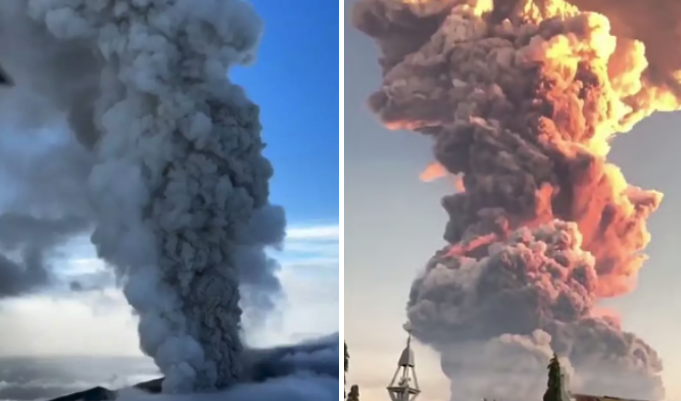Key Point Summary – Volcanos Erupt In Russia And Indonesia
- Krasheninnikov volcano in Russia erupted for the first time since 1463
- Eruption followed a massive 8.8-magnitude earthquake in Kamchatka
- Ash plume soared up to 28,000 ft, disrupting regional air traffic
- Japan and East Russia monitored potential tsunami impacts
- Indonesia’s Mt. Laki Laki also erupted, releasing large CO2 volumes
- Experts say volcanoes contribute <1% to global CO2 vs. human sources
- Public alarm rises as climate and seismic questions mount
Shocking Eruption After 562 Years Of Silence
Russia’s Far East has exploded into global headlines — literally. On August 2, 2025, the long-dormant Krasheninnikov volcano in Kamchatka roared back to life, belching a giant plume of ash high into the sky. It hadn’t erupted since around 1463.
The sudden eruption was captured in jaw-dropping footage now circulating on Russian media and social networks. Ash soared 5 to 6 kilometers into the air, painting the sky with a thick gray cloud and forcing authorities to scramble.
Orange Alert In Kamchatka Skies
The Kamchatka Volcanic Eruption Response Team wasted no time. They slapped an orange aviation code on the volcano — a serious warning for pilots and airports across the region. The towering ash plume, moving east at 10 knots, disrupted flights and sent shockwaves through the region.
The Tokyo-based Volcanic Ash Advisory Center clocked the ash at 28,000 feet, reaching an altitude where international planes regularly fly. Commercial airlines diverted routes, and local flights were grounded in panic.
Linked To Monster Quake?
The eruption didn’t happen in a vacuum. Just days earlier, the Kamchatka Peninsula was rocked by a terrifying 8.8-magnitude earthquake — among the most powerful quakes ever recorded. It triggered tsunami warnings stretching from Japan to Alaska.
Now scientists are investigating whether the quake cracked the region’s geological armor wide open, allowing magma to burst through. One thing’s certain: this wasn’t a coincidence.
Krasheninnikov sits inside a massive ancient caldera on Kamchatka’s east coast. It’s a double-headed stratovolcano, silent for over five centuries… until now.
Indonesia’s Mt. Laki Laki Joins The Chaos
Thousands of kilometers south, another volcano wasn’t about to be outdone. Mt. Laki Laki in Indonesia also erupted violently, spewing ash and an invisible — but no less dangerous — threat: carbon dioxide.
Billions of tonnes of CO2 surged into the atmosphere from Laki Laki’s vents. The twin eruptions have ignited global debate: Are volcanoes making climate change worse?
Scientists Say: Not So Fast
According to climate experts, volcanic CO2 emissions remain a drop in the bucket. While dramatic, their annual output — roughly 0.26 gigatons — is dwarfed by the staggering 40 gigatons from human industry, transport, and deforestation.
Natural emissions aren’t the real villain here, say experts. In fact, volcanoes can cool the climate by injecting sulfur dioxide into the stratosphere, forming sunlight-reflecting aerosols.
A famous example? Mt. Pinatubo’s 1991 eruption, which cooled global temperatures by nearly 0.6°C for two years. But don’t count on Krasheninnikov or Laki Laki to save us. Their impact, though dramatic, is likely short-lived.
Public On Edge Across The Pacific
In Kamchatka, fear and fascination spread fast. Local residents posted videos showing dark ash blanketing their towns. Some feared more eruptions. Others scrambled to evacuate.
Tour operators canceled excursions into Kronotsky Nature Reserve. Air masks flew off store shelves. The sound of the eruption — a deep, guttural roar — was reportedly heard up to 50 kilometers away.
Meanwhile in Indonesia, locals near Laki Laki were told to evacuate immediately. Emergency crews rushed to establish shelters. Health officials warned of long-term exposure risks to volcanic gases.
Climate Activists Cry Foul On Fossil Lobby
The twin eruptions gave climate skeptics a new talking point. “Nature emits CO2 too,” one influencer posted on X, formerly Twitter, racking up millions of views.
But climate scientists pushed back hard. “Yes, volcanos emit CO2. But their contribution is tiny — less than 1% of human emissions,” said Dr. Helena Greer of the International Climate Observatory. “Let’s not kid ourselves.”
She pointed out that the dramatic images mask a quieter, ongoing threat — man-made carbon overload, driven by burning coal, gas, and oil every single day.
Airports, Airlines On High Alert
In the hours following Krasheninnikov’s blast, pilots received rerouted flight plans. VAAC Tokyo issued continuous advisories for eastbound jets. Some cargo carriers diverted to avoid potential engine damage from ash particles.
In 2010, a similar eruption in Iceland stranded more than 100,000 passengers worldwide. Officials in Russia and Japan are determined not to repeat that chaos.
Seismic Swarm Raises More Fears
Adding to the anxiety, seismologists reported a “swarm” of smaller quakes continuing beneath Kamchatka. These tremors, sometimes precursors to larger eruptions, have kept scientists on edge.
Could Krasheninnikov blow again? Could another nearby volcano wake up? The region has 29 active volcanoes. Officials aren’t ruling out the possibility.
Global Eyes On Earth’s Fiery Wrath
From Alaska to Tokyo, volcanologists, pilots, and climate experts are watching the skies. Governments are reviewing emergency protocols. And the public, captivated by the raw footage, is asking tough questions about Earth’s growing volatility.
Is this the start of a pattern? Or just a freak coincidence?
Only time — and the restless Earth — will tell.




